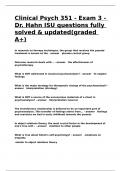Summary
Summary Master Macroeconomics: Comprehensive Grade 12 IEB Macroeconomics Study Guide
- Course
- Economics
- Institution
- 12th Grade
Master Macroeconomics with This All-in-One IEB Grade 12 Guide! Unlock the power of comprehensive Economics revision with this carefully designed study guide that covers the entire IEB Macroeconomics section—one of four exam components for Grade 12 Economics. These are my personal notes that I’...
[Show more]












